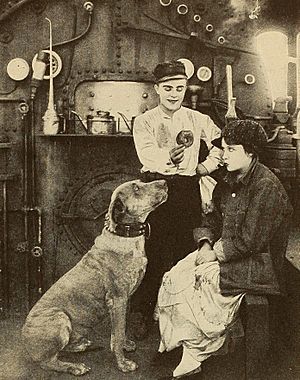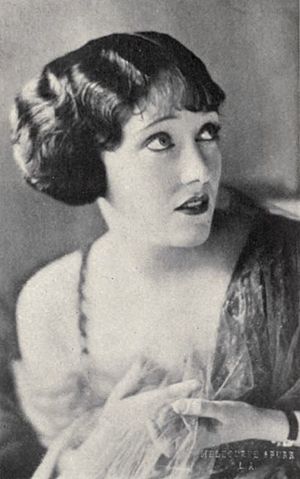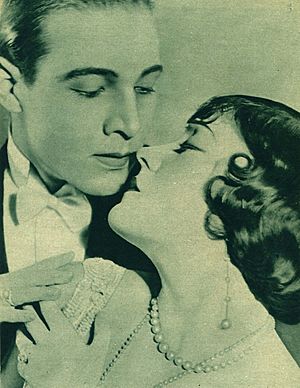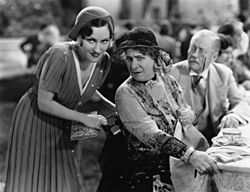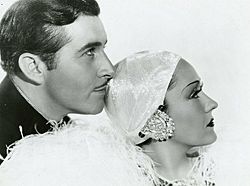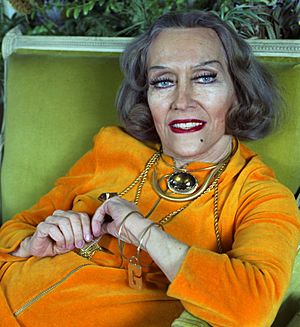Gloria Swanson facts for kids
Quick facts for kids
Gloria Swanson
|
|
|---|---|
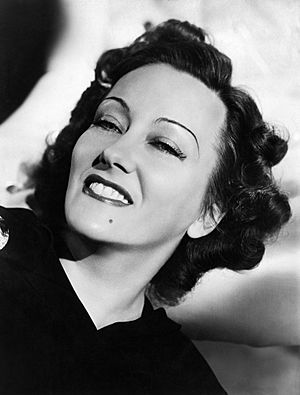
Swanson in 1941
|
|
| Born |
Gloria May Josephine Swanson
March 27, 1899 Chicago, Illinois, U.S.
|
| Died | April 4, 1983 (aged 84) New York City, U.S.
|
| Resting place | Church of the Heavenly Rest, New York City |
| Other names | Gloria Mae |
| Occupation |
|
| Years active | 1914–1983 |
| Political party | Republican |
| Spouse(s) |
Herbert K. Somborn
(m. 1919; div. 1922)Henry de La Falaise
(m. 1925; div. 1931)Michael Farmer
(m. 1931; div. 1934)William Davey
(m. 1945; div. 1946)William Dufty
(m. 1976) |
| Children | 3 |
| Signature | |
Gloria May Josephine Swanson (March 27, 1899 – April 4, 1983) was an American actress and producer. She first achieved fame acting in dozens of silent films in the 1920s and was nominated three times for the Academy Award for Best Actress, most famously for her 1950 return in Billy Wilder's Sunset Boulevard, which also earned her a Golden Globe Award.
Swanson was born in Chicago and raised in a military family that moved from base to base. Her infatuation with Essanay Studios actor Francis X. Bushman led to her aunt taking her to tour the actor's Chicago studio. The 15-year-old Swanson was offered a brief walk-on for one film, beginning her life's career in front of the cameras. Swanson was soon hired to work in California for Mack Sennett's Keystone Studios comedy shorts opposite Bobby Vernon.
She was eventually recruited by Famous Players-Lasky/Paramount Pictures, where she was put under contract for seven years and became a global superstar. She starred in a series of films about society, directed by Cecil B. DeMille, including Male and Female (1919). She continued as a successful movie star in The Affairs of Anatol (1921) and Beyond the Rocks (1922). She also starred in critically acclaimed performances such as Zaza (1923) and Madame Sans-Gêne (1925).
In 1925, Swanson joined United Artists as one of the film industry's pioneering women filmmakers. She produced and starred in the 1928 film Sadie Thompson, earning her a nomination for Best Actress at the first annual Academy Awards. Her sound film debut performance in 1929's The Trespasser, earned her a second Academy Award nomination. Queen Kelly (1928–29) was a box office disaster, but is remembered as a silent classic. After almost two decades in front of the cameras, her film success waned during the 1930s. Swanson received renewed praise for her comeback role in Sunset Boulevard (1950). She only made three more films, but guest starred on several television shows, and acted in road productions of stage plays.
Contents
Early life
Swanson was born in a small house in Chicago in 1899, the only child of Adelaide (née Klanowski) and Joseph Theodore Swanson (né Svensson), a soldier. She was raised in the Lutheran faith. Her father was a Swedish American and her mother was of German, French, and Polish ancestry. Because of her father's attachment to the U.S. Army, the family moved frequently. She spent some of her childhood in Key West, Florida, where she was enrolled in a Catholic convent school, and in Puerto Rico, where she saw her first motion pictures.
Career
1914–1918: Essanay/Keystone/Triangle
Her family once again residing in Chicago, the adolescent Gloria developed a crush on actor Francis X. Bushman and knew he was employed by Essanay Studios in the city. Swanson would later recall that her Aunt Inga brought her at age 15 to visit Bushman's studio, where she was discovered by a tour guide. Other accounts have the star-struck Swanson herself talking her way into the business. In either version, she was soon hired as an extra.
The movie industry was still in its infancy, churning out short subjects, without the advantage of today's casting agencies and talent agents promoting their latest find. A willing extra was often a valuable asset. Her first role was a brief walk-on with actress Gerda Holmes, that paid an enormous (in those days) $3.25. The studio soon offered her steady work at $13.25 (equivalent to $387 in 2022) per week. Swanson left school to work full-time at the studio. In 1915, she co-starred in Sweedie Goes to College with her future first husband Wallace Beery.
Swanson's mother accompanied her to California in 1916 for her roles in Mack Sennett's Keystone Studios comedy shorts opposite Bobby Vernon and directed by Clarence G. Badger. They were met at the train station by Beery, who was pursuing his own career ambitions at Keystone. Vernon and Swanson projected a great screen chemistry that proved popular with audiences. Director Charley Chase recalled that Swanson was "frightened to death" of Vernon's dangerous stunts. Surviving movies in which they appear together include The Danger Girl (1916), The Sultan's Wife (1917), and Teddy at the Throttle (1917). Badger was sufficiently impressed by Swanson to recommend her to the director Jack Conway for Her Decision and You Can't Believe Everything in 1918. Triangle had never put Swanson under contract, but did increase her pay to $15 a week. When she was approached by Famous Players-Lasky to work for Cecil B. DeMille, the resulting legal dispute obligated her to Triangle for several more months. Soon afterwards, Triangle was in a financial bind and loaned Swanson to DeMille for the comedy Don't Change Your Husband.
1919–1926: Famous Players-Lasky/Paramount Pictures
At the behest of DeMille, Swanson signed a contract with Famous Players-Lasky on December 30, 1918, for $150 a week, to be raised to $200 a week, and eventually $350 a week. Her first picture under her new contract was DeMille's World War I romantic drama For Better, for Worse. She made six pictures under the direction of DeMille, including Male and Female (1919) in which she posed with a lion as "Lion's Bride". While she and her father were dining out one evening, the man who would become her second husband, Equity Pictures president Herbert K. Somborn, introduced himself, by inviting her to meet one of her personal idols, actress Clara Kimball Young.
Why Change Your Wife? (1920), Something to Think About (1920), and The Affairs of Anatol (1921) soon followed. She next appeared in 10 films directed by Sam Wood, starting with The Great Moment (1921) and including Beyond the Rocks in 1922 with her longtime friend Rudolph Valentino. Valentino had become a star in 1921 for his appearance in The Four Horsemen of the Apocalypse, but Swanson had known him since his days as an aspiring actor getting small parts, with no seeming hope for his professional future. She was impressed by his shy, well-mannered personality, the complete opposite of what his public image would become.
After her films with Wood, she appeared in Zaza (1923) directed by Allan Dwan. During her time at Famous Players-Lasky, seven more of her films were directed by Dwan.
In 1925, Swanson starred in the French-American comedy Madame Sans-Gêne, directed by Léonce Perret. Filming was allowed for the first time at many of the historic sites relating to Napoleon. While it was well received at the time, no prints are known to exist and it is considered to be a lost film. Swanson appeared in a 1925 short produced by Lee de Forest in his Phonofilm sound-on-film process. She made a number of films for Paramount, including The Coast of Folly (1925), Stage Struck (1925) and The Untamed Lady (1926). Before she could produce films with United Artists, she completed Fine Manners with Paramount and turned down an offer to make The King of Kings with DeMille.
1925–1933: United Artists
She turned down a one-million-dollar-a-year (equivalent to $16,800,000 in 2022) contract with Paramount to join the newly created United Artists partnership on June 25, 1925, accepting a six-picture distribution offer from president Joseph Schenck. At the time, Swanson was considered the most bankable star of her era. United Artists had its own Art Cinema Corporation subsidiary to advance financial loans for the productions of individual partners. The partnership agreement included her commitment to a buy-in of $100,000 of preferred stock subscription.
Swanson Producing Corporation
The Swanson Producing Corporation was set up as the umbrella organization for her agreement with United Artists. Under that name, she produced The Love of Sunya with herself in the title role. The film co-starring John Boles was directed by Albert Parker, based on the play The Eyes of Youth, by Max Marcin and Charles Guernon. The production was a disaster, with Parker being indecisive and the actors not experienced enough to deliver the performances she wanted. The film fell behind in its schedule, and by the time of its release, the end product had not lived up to Swanson's expectations. While it did not lose money, it was a financial wash, breaking even on the production costs.

Gloria Productions
By the end of 1927, Swanson was in dire financial straits, with only $65 in the bank. Her two productions had generated income, but too slowly to offset her production loan debts to Art Cinema Corporation. Swanson had also not made good on her $100,000 subscription for preferred United Artists shared stock. She had received financial proposals from United Artists studio head Joseph Schenck, as well as from Bank of America, prior to engaging the services of Joseph P. Kennedy Sr. as her financial advisor. He proposed to personally bankroll her next picture and conducted a thorough examination of her financial records. Kennedy advised her to shut down Swanson Producing Corporation. She agreed to his plan for a fresh start under the dummy corporate name of Gloria Productions, headquartered in Delaware. Upon his advice, she fired most of her staff and sold her rights for The Love of Sunya and Sadie Thompson to Art Cinema Corporation. Kennedy then created the position of "European director of Pathé" to put her third husband Henry de La Falaise on the payroll.
Sound films were already becoming popular with audiences, most notably the films of singer Al Jolson, who had success with The Jazz Singer released in 1927 and The Singing Fool in 1928. Kennedy, however, advised her to hire Erich von Stroheim to direct another silent film, The Swamp, subsequently retitled Queen Kelly. She was hesitant to hire Stroheim, who was known for being difficult to deal with and who was unwilling to work within any budget. Kennedy, nevertheless, was insistent and was able to get Stroheim released from contractual obligations to producer Pat Powers. Stroheim worked for several months on writing the basic script. Filming of Queen Kelly began in November. His filming was slow, albeit meticulous, and the cast and crew suffered from long hours. Shooting was shut down in January, and Stroheim fired, after complaints by Swanson about him and about the general direction the film was taking. Swanson and Kennedy tried to salvage it with an alternative ending shot on November 24, 1931, directed by Swanson and photographed by Gregg Toland.
Only two other films were made under Gloria Productions. The Trespasser in 1929 was a sound production, and garnered Swanson her second Oscar nomination. Written by Edmund Goulding, with Laura Hope Crews fine-tuning the dialogue, Kennedy approved funding for the go-ahead on the production. The film was a melodrama, complete with musical numbers sung by Swanson and completed in 21 days. The world premiere was held in London, the first American sound production to do so. Swanson was mobbed by adoring fans. Before leaving London, she sang at a concert carried over the BBC. What a Widow! in 1930 was the final film for Gloria Productions.
United Artists stars on the radio
Mary Pickford and her husband Douglas Fairbanks hosted the March 29, 1928, episode of the Dodge Hour radio program, originating from Pickford's private bungalow at United Artists, and broadcast to audiences in American movie theaters. The brainchild of Joseph Schenck, it was a promotional come-on to attract audiences into movie theaters to hear the voices of their favorite actors, as sound productions became the future of commercial films. On hand were Swanson, Charlie Chaplin, Norma Talmadge, John Barrymore, Dolores del Río and D. W. Griffith.
Gloria Swanson British Productions Ltd.

Before she began filming Perfect Understanding as Gloria Swanson British Productions Ltd., she finished a two-film package production for Art Cinema, which included Indiscreet and Tonight or Never (1931). Perfect Understanding, a 1933 sound production comedy, was the only film produced by this company. Made entirely at Ealing Studios, it co-starred Laurence Olivier as Swanson's on-screen husband. United Artists bought back all of her stock with them, in order to provide her financing to make this film, and thereby ending her relationship with the partnership. The film was panned by the critics upon its release and failed at the box office.
1938–1950: Creating new paths
When she made the transition to sound films as her career simultaneously began to decline, Swanson moved permanently to New York City in 1938. Swanson starred in Father Takes a Wife for RKO in 1941. She began appearing in stage productions and starred in The Gloria Swanson Hour on WPIX-TV in 1948. Swanson threw herself into painting and sculpting and, in 1954, published Gloria Swanson’s Diary, a general newsletter. She toured in summer stock, engaged in political activism, designed and marketed clothing and accessories, and made personal appearances on radio and in movie theaters.
1950 – 1977: Later career
Sunset Boulevard
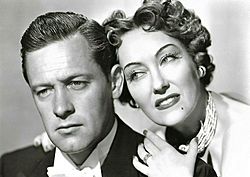
“It should be pointed out that Gloria Swanson was not Norma Desmond. Unlike her delusional screen counterpart, Swanson was fiercely realistic. She lived in the present –not in the past– and pursued many interests with passionate zeal. She was also a good actress. Judging by the number of people who think she was Norma Desmond, maybe a little too good.” – Biographer Lon Davis in Silent Lives: 100 Biographies of the Silent Film Era. (2008).
The film Sunset Boulevard was conceived by director Billy Wilder and screenwriter Charles Brackett, and came to include writer D. M. Marshman Jr. They bandied about the name of Mae West, but she objected to playing a has-been. Mary Pickford was also considered for the lead role of Norma Desmond. It was director George Cukor who suggested Swanson, noting that she was once such a valuable asset to her studio that she was, "...carried in a sedan chair from her dressing room to the set".
Although Swanson had objected to enduring a screen test for the film, she had been glad to be making much more money than she had been in television and on stage. She found the overall experience of making the movie a pleasure, and later stated, "I hated to have the picture end ... When Mr. Wilder called ‘Print it!’ I burst into tears...” She was nominated for a Best Actress Academy Award, but lost to Judy Holliday.
Final films
Swanson received several acting offers following the release of Sunset Boulevard, but turned most of them down, saying they tended to be pale imitations of Norma Desmond. Her last major Hollywood motion picture role was also her first color film, the poorly received 3 for Bedroom C in 1952. Nationally syndicated columnist Suzy called it "one of the worst movies ever made." In 1956, Swanson made Nero's Mistress, an Italian film shot in Rome, which starred Alberto Sordi, Vittorio de Sica and Brigitte Bardot. Her final screen appearance was as herself in Airport 1975.
Television and theatre

Swanson hosted The Gloria Swanson Hour, one of the first live television series in 1948 in which she invited friends and others to be guests. Swanson later hosted Crown Theatre with Gloria Swanson, a television anthology series in which she occasionally acted.
Through the 1960s, 1970s, and early 1980s, Swanson appeared on many different talk and variety shows such as The Carol Burnett Show and The Tonight Show Starring Johnny Carson to recollect her movies and to lampoon them as well. On The Carol Burnett Show in 1973, Swanson reprised her impersonation of Charlie Chaplin from both Sunset Boulevard and Manhandled. She was the "mystery guest" on What's My Line. She acted in "Behind the Locked Door" on The Alfred Hitchcock Hour in 1964 and, in the same year, she was nominated for a Golden Globe award for her performance in Burke's Law. She made a guest appearance on The Dick Cavett Show in the summer of 1970; a guest on the same show as Janis Joplin. She made a notable appearance in a 1966 episode of The Beverly Hillbillies, in which she plays herself. In the episode, the Clampetts mistakenly believe Swanson is destitute and decide to finance a comeback movie for her – in a silent film.
After near-retirement from movies, Swanson appeared in many plays throughout her later life, beginning in the 1940s. Actor and playwright Harold J. Kennedy, who had learned the ropes at Yale and with Orson Welles' Mercury Theatre, suggested Swanson do a road tour of "Reflected Glory", a comedy that had run on the Broadway stage with Tallulah Bankhead as its star. Kennedy wrote the script for the play A Goose for the Gander, which began its road tour in Chicago in August 1944.
Swanson also toured with Let Us Be Gay. After her success with Sunset Boulevard, she starred on Broadway in a revival of Twentieth Century with José Ferrer, and in Nina with David Niven. Her last major stage role was in the 1971 Broadway production of Butterflies Are Free at the Booth Theatre. Kevin Brownlow and David Gill interviewed her for Hollywood, a television history of the silent era.
Personal life
Swanson was a vegetarian and an early health food advocate who was known for bringing her own meals to public functions in a tin box. In 1975, Swanson traveled the United States and helped to promote the book Sugar Blues written by her husband, William Dufty. He also ghostwrote Swanson's 1981 autobiography Swanson on Swanson, which became a commercial success. The same year, she designed a stamp cachet for the United Nations Decade for Women, which was her last creative project.
She was a pupil of the yoga guru Indra Devi and was photographed performing a series of yoga poses, reportedly looking much younger than her age, for Devi to use in her book Forever Young, Forever Healthy; but the publisher Prentice-Hall decided to use the photographs for Swanson's book, not Devi's. In return, Swanson, who normally never did publicity events, helped to launch Devi's book at the Waldorf-Astoria in 1953.
As a Republican she supported the 1940 and 1944 campaigns for president of Wendell Willkie and the 1964 presidential campaign of Barry Goldwater. In 1980, she chaired the New York chapter of Seniors for Reagan-Bush.
In 1964, Swanson spoke at a "Project Prayer" rally attended by 2,500 at the Shrine Auditorium in Los Angeles. The gathering, which was hosted by Anthony Eisley, a star of ABC's Hawaiian Eye series, sought to flood the United States Congress with letters in support of mandatory school prayer, following two decisions in 1962 and 1963 of the United States Supreme Court, which struck down mandatory prayer as conflicting with the Establishment Clause of the First Amendment to the United States Constitution. Joining Swanson and Eisley at the Project Prayer rally were Walter Brennan, Lloyd Nolan, Rhonda Fleming, Pat Boone, and Dale Evans. Swanson declared "Under God we became the freest, strongest, wealthiest nation on earth. Should we change that?"
Marriages and relationships
Wallace Beery
Wallace Beery and Swanson married on her 17th birthday on March 27, 1916, but soon, unhappy with her husband and his family, she filed for divorce, which was finalized on December 12, 1918.
Herbert K. Somborn
She married Herbert K. Somborn on December 20, 1919. He was at that time president of Equity Pictures Corporation and later the owner of the Brown Derby restaurant. Their daughter, Gloria Swanson Somborn, was born October 7, 1920. In 1923, she adopted 1-year-old Sonny Smith, whom she renamed Joseph Patrick Swanson after her father. Somborn was granted a divorce in Los Angeles, on September 19, 1923.
Henri de la Falaise
During the production of Madame Sans-Gêne, Swanson met her third husband, Henri, Marquis de la Falaise (commonly known as Henri de la Falaise), who had been hired to be her translator during the film's production. Though Henri was a Marquis and related to the famous Hennessy cognac family, he had no personal wealth. They married on January 28, 1925, after the Somborn divorce was finalized. A few months later, they returned to the United States as European nobility. Swanson now held the title of Marquise. She received a huge welcome home with parades in both New York and Los Angeles. He became a film executive representing Pathé (USA) in France. This marriage ended in divorce in 1930.
In spite of the divorce, they remained close and Falaise became a partner in her World War II efforts to aid potential scientist refugees fleeing from behind Nazi lines. Swanson described herself as a "mental vampire", someone with a searching curiosity about how things worked, and who pursued the possibilities of turning those ideas into reality. In 1939, she created Multiprises, an inventions and patents company; Henri de la Falaise provided a transitional Paris office for the scientists and gave written documentation to authorities guaranteeing jobs for them. Viennese electronics engineer Richard Kobler, chemist Leopold Karniol, metallurgist Anton Kratky, and acoustical engineer Leopold Neumann, were brought to New York and headquartered in Rockefeller Center. The group nicknamed her "Big Chief".
Michael Farmer
After the marriage to Henri was over, Swanson became acquainted with Michael Farmer, the man who would become her fourth husband. They met by chance in Paris when Swanson was being fitted by Coco Chanel for her 1931 film Tonight or Never. Farmer was a man of independent financial means who seemed not to have been employed. They married on August 16, 1931, and separated 2 years later.
Because of the possibility that Swanson's divorce from La Falaise had not been finalized at the time of the wedding, she was forced to remarry Farmer the following November, by which time she was four months pregnant with Michelle Bridget Farmer, who was born on April 5, 1932.
William M. Davey
Davey was a wealthy investment broker whom Swanson met in October 1944 while she was appearing in A Goose for the Gander. They married January 29, 1945. Swanson had initially thought she was going to be able to retire from acting, but the marriage was troubled from the start. The marriage soon ended with Davey's death.
William Dufty
Swanson's final marriage occurred in 1976 and lasted until her death. Her sixth husband William Dufty was a writer who worked for many years at the New York Post, where he was assistant to the editor from 1951 to 1960. He was the co-author (ghostwriter) of Billie Holiday's autobiography Lady Sings the Blues, the author of Sugar Blues, a 1975 best-selling health book still in print, and the author of the English version of Georges Ohsawa's You Are All Sanpaku. They met in the mid-1960s and moved in together. Swanson shared her husband's enthusiasm for macrobiotic diets, and they traveled widely together to speak about nutrition. Swanson and her husband first got to know John Lennon and Yoko Ono because they were fans of Dufty's work. Swanson testified on Lennon's behalf at his immigration hearing in New York City, which led to his becoming a permanent resident. Besides her Fifth Avenue apartment, she and Dufty spent time at their homes in Beverly Hills, California; Colares, Portugal; Croton-on-Hudson, New York; and Palm Springs, California. After Swanson's death, Dufty returned to his former home in Birmingham, Michigan. He died of cancer in 2002.
Death
Swanson died of a heart ailment at the New York Hospital on April 4, 1983. She had just returned from her home in the Portuguese Riviera. She was cremated and her ashes interred at the Episcopal Church of the Heavenly Rest on Fifth Avenue in New York City, attended by only a small circle of family. The church was the same one where the funeral of Chester A. Arthur had taken place.
After Swanson's death, there was a series of auctions from August to September 1983 at William Doyle Galleries in New York. Collectors bought her furniture and decorations, jewelry, clothing, and memorabilia from her personal life and career.
Honors and legacy
In 1960, Gloria Swanson was honored with two stars on the Hollywood Walk of Fame: one for motion pictures at 6750 Hollywood Boulevard, and another for television at 6301 Hollywood Boulevard. In 1955 and 1957, Swanson was awarded The George Eastman Award, given by George Eastman House for distinguished contribution to the art of film, and in 1966, the museum honored her with a career film retrospective, titled A Tribute to Gloria Swanson, which screened several of her movies. In 1974, Swanson was one of the honorees of the first Telluride Film Festival. A parking lot by Sims Park in downtown New Port Richey, Florida, is named after the star, who is said to have owned property along the Cotee River.
In 1982, a year before her death, Swanson sold her archives of over 600 boxes for an undisclosed sum, including photographs, artwork, copies of films and private papers, including correspondence, contracts, and financial dealings, to the Harry Ransom Center at the University of Texas at Austin. Upon her death in 1983, much of the remainder of her holdings was purchased by UT-Austin at an auction held at the Doyle New York gallery. An undisclosed amount of memorabilia was also gifted to the HRC Center between 1983 and 1988.
In 1989, the Library of Congress chose Sunset Boulevard, along with 24 other films, "to be preserved in the permanent collection of the National Film Registry of the Library of Congress as culturally, historically, and aesthetically important".
Portrayals
Swanson has been played both on television and in film by the following actresses:
- 1971: Carol Burnett on The Carol Burnett Show
- 1984: Diane Venora in The Cotton Club
- 1990: Madolyn Smith in The Kennedys of Massachusetts
- 1991: Ann Turkel in White Hot: The Mysterious Murder of Thelma Todd
- 2008: Kristen Wiig in Saturday Night Live
- 2013: Debi Mazar in Return to Babylon
Stage
Note: The list below is limited to New York Broadway theatrical productions.
| Title | Date | Role | Ref(s) |
|---|---|---|---|
| A Goose for the Gander | January 23, 1945 – February 3, 1945 | Katherine | |
| Bathsheba | March 26, 1947 – April 19, 1947 | ||
| Twentieth Century | December 24, 1950 – June 2, 1951 | Lily Garland | |
| Nina | December 5, 1951 – January 12, 1952 | Nina | |
| Butterflies Are Free | September 7, 1971 – July 2, 1972 | Mrs. Baker |
Filmography
Shorts
| Title | Year | Role | Notes Studio/Distributor |
Ref(s) |
|---|---|---|---|---|
| The Song of the Soul | 1914 | Unconfirmed | ||
| The Misjudged Mr. Hartley | 1915 | Maid | ||
| At the End of a Perfect Day | 1915 | Hands Bouquet to Holmes | Uncredited, actual release date of January 26, 2015 | |
| The Ambition of the Baron | 1915 | Bit part | Essanay Film starring Francis X. Bushman |
|
| His New Job | 1915 | Stenographer | Essanay Film Written and directed by Charlie Chaplin |
|
| The Fable of Elvira and Farina and the Meal Ticket | 1915 | Farina, Elvira's Daughter | Credited as Gloria Mae Essanay Film |
|
| Sweedie Goes to College | 1915 | College Girl | Wallace Beery played Sweedie in a series of shorts Essanay Film |
|
| The Romance of an American Duchess | 1915 | Minor Role | Uncredited Essanay Film |
|
| The Broken Pledge | 1915 | Gloria | Essanay Film | |
| A Dash of Courage | 1916 | Keystone/Triangle with Bobby Vernon directed by Clarence G. Badger |
||
| Hearts and Sparks | 1916 | Keystone/Triangle with Bobby Vernon directed by Clarence G. Badger |
||
| A Social Cub | 1916 | Keystone/Triangle with Bobby Vernon directed by Clarence G. Badger |
||
| The Danger Girl | 1916 | Reggie's madcap sister | Keystone/Triangle with Bobby Vernon directed by Clarence G. Badger |
|
| Haystacks and Steeples | 1916 | Keystone/Triangle with Bobby Vernon directed by Clarence G. Badger |
||
| The Nick of Time Baby | 1916 | Keystone/Triangle with Bobby Vernon directed by Clarence G. Badger |
||
| Teddy at the Throttle | 1917 | Gloria Dawn, His Sweetheart | Uncredited with Bobby Vernon Keystone/Triangle directed by Clarence G. Badger |
|
| Baseball Madness | 1917 | Victor Film/Universal | ||
| Dangers of a Bride | 1917 | Keystone/Triangle directed by Clarence G. Badger |
||
| Whose Baby? | 1917 | Keystone/Triangle with Bobby Vernon directed by Clarence G. Badger |
||
| The Sultan's Wife | 1917 | Gloria | Keystone/Triangle with Bobby Vernon directed by Clarence G. Badger |
|
| The Pullman Bride | 1917 | The Girl | Paramount-Mack Sennett directed by Clarence G. Badger |
|
| A Trip to Paramountown | 1922 | Herself | Paramount |
Features
| Title | Year | Role | Notes Studio/Distributor |
Ref(s) |
|---|---|---|---|---|
| Society for Sale | 1918 | Phylis Clyne | Triangle Film Corporation | |
| Her Decision | 1918 | Phyllis Dunbar | Triangle Film Corporation directed by Jack Conway |
|
| You Can't Believe Everything | 1918 | Patricia Reynolds | Triangle Film Corporation directed by Jack Conway |
|
| Station Content | 1918 | Kitty Manning | Triangle Film Corporation directed by Arthur Hoyt |
|
| Everywoman's Husband | 1918 | Edith Emerson | Triangle Film Corporation directed by Gilbert P. Hamilton |
|
| Shifting Sands | 1918 | Marcia Grey | Triangle Film Corporation directed by Albert Parker |
|
| The Secret Code | 1918 | Sally Carter Rand | Triangle Film Corporation directed by Albert Parker |
|
| Wife or Country | 1918 | Sylvia Hamilton | Triangle Film Corporation directed by E. Mason Hopper |
|
| Don't Change Your Husband | 1919 | Leila Porter | Famous Players-Lasky/Paramount directed by Cecil B. DeMille |
|
| For Better, for Worse | 1919 | Sylvia Norcross | Famous Players-Lasky/Paramount directed by Cecil B. DeMille |
|
| Male and Female | 1919 | Lady Mary Lasenby | Famous Players-Lasky/Paramount directed by Cecil B. DeMille |
|
| Why Change Your Wife? | 1920 | Beth Gordon | Famous Players-Lasky/Paramount directed by Cecil B. DeMille |
|
| Something to Think About | 1920 | Ruth Anderson | Famous Players-Lasky/Paramount directed by Cecil B. DeMille |
|
| The Affairs of Anatol | 1921 | Vivian Spencer – Anatol's Wife | Famous Players-Lasky/Paramount directed by Cecil B. DeMille |
|
| The Great Moment | 1921 | Nada Pelham/Nadine Pelham | Famous Players-Lasky/Paramount directed by Sam Wood |
|
| Under the Lash | 1921 | Deborah Krillet | Famous Players-Lasky/Paramount directed by Sam Wood |
|
| Don't Tell Everything | 1921 | Marian Westover | Famous Players-Lasky/Paramount directed by Sam Wood |
|
| Her Husband's Trademark | 1922 | Lois Miller | Famous Players-Lasky/Paramount directed by Sam Wood |
|
| Her Gilded Cage | 1922 | Suzanne Ornoff | Famous Players-Lasky/Paramount directed by Sam Wood |
|
| Beyond the Rocks | 1922 | Theodora Fitzgerald | Famous Players-Lasky/Paramount directed by Sam Wood |
|
| The Impossible Mrs. Bellew | 1922 | Betty Bellew | Famous Players-Lasky/Paramount directed by Sam Wood |
|
| My American Wife | 1922 | Natalie Chester | Famous Players-Lasky/Paramount directed by Sam Wood |
|
| Prodigal Daughters | 1923 | Swifty Forbes | Famous Players-Lasky/Paramount directed by Sam Wood |
|
| Bluebeard's 8th Wife | 1923 | Mona deBriac | Famous Players-Lasky/Paramount directed by Sam Wood |
|
| Hollywood | 1923 | Cameo role | Famous Players-Lasky/Paramount | |
| Zaza | 1923 | Zaza | Famous Players-Lasky/Paramount directed by Allan Dwan |
|
| The Humming Bird | 1924 | Toinette | Famous Players-Lasky/Paramount directed by Sidney Olcott |
|
| A Society Scandal | 1924 | Marjorie Colbert | Famous Players-Lasky/Paramount directed by Allan Dwan |
|
| Manhandled | 1924 | Tessie McGuire | Famous Players-Lasky/Paramount directed by Allan Dwan |
|
| Her Love Story | 1924 | Princess Marie | Famous Players-Lasky/Paramount directed by Allan Dwan |
|
| Wages of Virtue | 1924 | Carmelita | Famous Players-Lasky/Paramount directed by Allan Dwan |
|
| Madame Sans-Gêne | 1925 | Madame Sans-Gêne | Famous Players-Lasky/Paramount directed by Léonce Perret |
|
| The Coast of Folly | 1925 | Joyce Gathway/Nadine Gathway | Famous Players-Lasky/Paramount directed by Allan Dwan |
|
| Stage Struck | 1925 | Jennie Hagen | Famous Players-Lasky/Paramount directed by Allan Dwan |
|
| The Untamed Lady | 1926 | St. Clair Van Tassel | Famous Players-Lasky/Paramount directed by Frank Tuttle |
|
| Fine Manners | 1926 | Orchid Murphy | Famous Players-Lasky/Paramount directed by Richard Rosson |
|
| The Love of Sunya | 1927 | Sunya Ashling | Swanson Producing Corporation/United Artists directed by Albert Parker |
|
| Sadie Thompson | 1928 | Sadie Thompson | Gloria Swanson Productions/United Artists directed by Raoul Walsh |
|
| Queen Kelly | 1928 | Kitty Kelly/Queen Kelly | Joseph P. Kennedy/United Artists directed by Erich von Stroheim |
|
| The Trespasser | 1929 | Marion Donnell | Gloria Productions/United Artists directed by Edmund Goulding Released in two versions, one silent, and the other with sound |
|
| What a Widow! | 1930 | Tamarind Brook | Gloria Productions/United Artists directed by Allan Dwan |
|
| Indiscreet | 1931 | Geraldine "Gerry" Trent | Feature Productions, Inc. A DeSylva, Brown & Henderson Production directed by Leo McCarey |
|
| Tonight or Never | 1931 | Nella Vago | Feature Productions, Inc./United Artists directed by Mervyn LeRoy |
|
| Perfect Understanding | 1933 | Judy Rogers | Gloria Swanson British Productions, Ltd./United Artists directed by Cyril Gardner |
|
| Music in the Air | 1934 | Frieda Hotzfelt | Erich Pommer Productions/Fox Film directed by Joe May |
|
| Father Takes a Wife | 1941 | Leslie Collier Osborne | Marcus Lee/RKO Radio Pictures, Inc. directed by William Dorfman |
|
| Sunset Boulevard | 1950 | Norma Desmond | Charles Brackett/Paramount directed by Billy Wilder |
|
| 3 for Bedroom "C" | 1952 | Ann Haven/costume designer | Brenco Pictures Corporation/Warner Bros. directed by Milton H. Bren |
|
| Nero's Weekend (aka Nero's Mistress) | 1956 | Agrippina | Les Films Marceau and Titanus/Manhattan Films International directed by Steno |
|
| Airport 1975 | 1974 | Herself | Universal Pictures directed by Jack Smight |
Television
| Title | Year | Role | Notes | Ref(s) |
|---|---|---|---|---|
| The Gloria Swanson Hour | 1948 | Hostess | Variety show | |
| The Peter Lind Hayes Show | 1950 | Herself | Episode #1.1 sitcom show |
|
| Hollywood Opening Night | 1953 | Episode: "The Pattern" | ||
| Crown Theatre with Gloria Swanson | 1954–1955 | Hostess | 25 episodes | |
| The Steve Allen Show | 1957 | Norma Desmond | Episode #3.8 | |
| Straightaway | 1961 | Lorraine Carrington | Episode: "A Toast to Yesterday" | |
| Dr. Kildare | 1963 | Julia Colton | Episode: "The Good Luck Charm" | |
| Burke's Law | 1963–1964 | Various roles | 2 episodes | |
| Kraft Suspense Theatre | 1964 | Mrs. Charlotte Heaton | Segment: "Who Is Jennifer?" | |
| The Alfred Hitchcock Hour | 1964 | Mrs. Daniels | Episode: "Behind the Locked Door" | |
| My Three Sons | 1965 | Margaret McSterling | Episode: "The Fountain of Youth" | |
| Ben Casey | 1965 | Victoria Hoffman | Episode: "Minus That Rusty Old Hacksaw" | |
| The Beverly Hillbillies | 1966 | Herself | Episode: "The Gloria Swanson Story" | |
| The Eternal Tramp Special | 1972 | Narrator | aka Chaplinesque, My Life and Hard Times | |
| The Carol Burnett Show | 1973 | Herself | Episode #7.3 | |
| Killer Bees | 1974 | Madame Maria von Bohlen | Television movie | |
| The Great Debate | 1974 | Herself | Canadian interview show with James Bawden | |
| Hollywood | 1980 | Herself | Television documentary |
Awards and nominations
| Year | Award | Result | Category | Film or series | Ref(s) |
|---|---|---|---|---|---|
| 1929 | Academy Award | Nominated | Best Actress | Sadie Thompson | |
| 1931 | The Trespasser | ||||
| 1951 | Sunset Boulevard | ||||
| 1951 | Golden Globe Award | Won | Best Actress – Motion Picture Drama | ||
| 1964 | Nominated | Best TV Star – Female | Burke's Law | ||
| 1951 | Italian National Syndicate of Film Journalists | Won | Best Actress – Foreign Film (Migliore Attrice Straniera) | Sunset Boulevard | |
| 1951 | Jussi Award | Won | Best Foreign Actress | ||
| 1950 | National Board of Review of Motion Pictures | Won | Best Actress | ||
| 1980 | Career Achievement Award |
|
|||
| 1975 | Saturn Award | Won | Special Award |
|
See also
 In Spanish: Gloria Swanson para niños
In Spanish: Gloria Swanson para niños
- List of actors with Academy Award nominations


